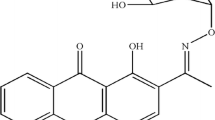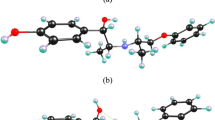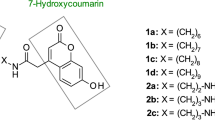Abstract
Evaluating the binding interaction between biomacromolecules and various chemical compounds is one of the most biologically researched topics. The present experimental study attempted to investigate the binding interaction between two types of acridone derivative, namely 8-chloro acridone (CA) and nitrile cyanide acridone (NCA) as antineoplastic agents and calf thymus DNA (ctDNA) by applying various spectroscopic techniques. The binding interactions were first characterized by fluorescence quenching experiments, and it was demonstrated that NCA had higher affinity to ctDNA and bound to it more tightly. Further analysis indicated that the quenching process between CA and ctDNA was controlled by a dynamic mechanism, while the dominant process in ctDNA–NCA interaction was static. Analysis of thermodynamic parameters showed that hydrophobic forces played a key role in the interaction between ctDNA and CA, whereas ctDNA–NCA complex was mainly stabilized by van der Waals interactions. In terms of the latter interaction, external binding also contributed to the stabilization of the formed complex. On the basis of RLS results, we concluded that CA had stronger potential toxicity on ctDNA than NCA. Fluorescence competition studies aimed at uncovering the mode of binding and indicated that CA and NCA probably intercalated into ctDNA. Thermal denaturation studies confirmed the displacement experiments and showed that CA brought about a stronger effect on the ctDNA stabilization. Data gathered by spectroscopy studies were further supported by viscosity experiments. These studies also showed that CA and NCA intercalated into ctDNA by a non-classical and classical mode, respectively. The results of circular dichroism experiments revealed no considerable conformational transition occurred in ctDNA upon the binding interactions and ctDNA remained in B-form. Based on the spectroscopic results and the binding affinity of CA to double-strand and single-strand ctDNA, we inferred that although CA predominantly intercalated into ctDNA, a small population of its molecules might bind to the grooves of ctDNA. In case of NCA, all the experimental results confirmed that NCA molecules intercalated into ctDNA by a classical mode.












Similar content being viewed by others
References
S.R. Wente, M.P. Rout, The nuclear pore complex and nuclear transport. Cold Spring Harbor Perspect. Biol. 2, a000562 (2010)
Y. Sakiyama, R. Panatala, R.Y. Lim, Structural dynamics of the nuclear pore complex. in Seminars in Cell and Developmental Biology: 2017. (Elsevier, Amsterdam, 2017), pp. 27–33
M. Capelson, Nuclear pores and the genome. in Nuclear Architecture and Dynamics, ed. by C. Lavelle, J.-M. Victor (Elsevier, Amsterdam, 2018), pp. 369–385
M. Sirajuddin, S. Ali, A. Badshah, Drug–DNA interactions and their study by UV–visible, fluorescence spectroscopies and cyclic voltametry. J. Photochem. Photobiol., B 124, 1–19 (2013)
X. Zhang, L. Chen, X.-C. Fei, Y.-S. Ma, H.-W. Gao, Binding of PFOS to serum albumin and DNA: insight into the molecular toxicity of perfluorochemicals. BMC Mol. Biol. 10(1), 16 (2009)
J. Sheng, J. Gan, Z. Huang, Structure-based DNA-targeting strategies with small molecule ligands for drug discovery. Med. Res. Rev. 33(5), 1119–1173 (2013)
C.T. Winston, D.L. Boger, Sequence-selective DNA recognition: natural products and nature’s lessons. Chem. Biol. 11(12), 1607–1617 (2004)
N. Narayanaswamy, S. Das, P.K. Samanta, K. Banu, G.P. Sharma, N. Mondal, S.K. Dhar, S.K. Pati, T. Govindaraju, Sequence-specific recognition of DNA minor groove by an NIR-fluorescence switch-on probe and its potential applications. Nucleic Acids Res. 43(18), 8651–8663 (2015)
I. Haq, Thermodynamics of drug–DNA interactions. Arch. Biochem. Biophys. 403(1), 1–15 (2002)
Y.M. Delahoussaye, M.P. Hay, F.B. Pruijn, W.A. Denny, J.M. Brown, Improved potency of the hypoxic cytotoxin tirapazamine by DNA-targeting. Biochem. Pharmacol. 65(11), 1807–1815 (2003)
K.R. Fox, M.J. Waring, DNA structural variations produced by actinomycin and distamycin as revealed by DNAase I footprinting. Nucleic Acids Res. 12(24), 9271–9285 (1984)
A. Guttman, N. Cooke, Capillary gel affinity electrophoresis of DNA fragments. Anal. Chem. 63(18), 2038–2042 (1991)
V. Yerragunta, E.S. Reddy, M. Kishore, H.O.P. Rao, A. Sadia, A. Saba, S.K. Fatima, A Review on Acridone Derivatives and its Importance. PharmaTutor 3(10), 27–29 (2015)
P. Belmont, J. Bosson, T. Godet, M. Tiano, Acridine and acridone derivatives, anticancer properties and synthetic methods: where are we now? Anti-Cancer Agents Med. Chem. (Formerly Current Medicinal Chemistry-Anti-Cancer Agents) 7(2), 139–169 (2007)
V.R. Prasad, J.V. Rao, R. Giri, N. Sathish, S.S. Kumar, Y. Mayur, Chloro acridone derivatives as cytotoxic agents active on multidrug-resistant cell lines and their duplex DNA complex studies by electrospray ionization mass spectrometry. Chem. Biol. Interact. 176(2–3), 212–219 (2008)
M.O. Anderson, J. Sherrill, P.B. Madrid, A.P. Liou, J.L. Weisman, J.L. DeRisi, R.K. Guy, Parallel synthesis of 9-aminoacridines and their evaluation against chloroquine-resistant Plasmodium falciparum. Bioorg. Med. Chem. 14(2), 334–343 (2006)
W.A. Denny, Acridine derivatives as chemotherapeutic agents. Curr. Med. Chem. 9(18), 1655–1665 (2002)
A. Rescifina, C. Zagni, M.G. Varrica, V. Pistara, A. Corsaro, Recent advances in small organic molecules as DNA intercalating agents: synthesis, activity, and modeling. Eur. J. Med. Chem. 74, 95–115 (2014)
P. Belmont, I. Dorange, Acridine/acridone: a simple scaffold with a wide range of application in oncology. Expert Opin. Ther. Pat. 18(11), 1211–1224 (2008)
M. Rahimizadeh, M. Pordel, M. Bakavoli, Z. Bakhtiarpoor, A. Orafaie, Synthesis of imidazo [4, 5-a] acridones and imidazo [4, 5-a] acridines as potential antibacterial agents. Monatshefte für Chemie-Chemical Monthly 140(6), 633 (2009)
H.A. Benesi, J. Hildebrand, A spectrophotometric investigation of the interaction of iodine with aromatic hydrocarbons. J. Am. Chem. Soc. 71(8), 2703–2707 (1949)
G. Zhang, Y. Zhang, Y. Zhang, Y. Li, Spectroscopic studies of cyanazine binding to calf thymus DNA with the use of ethidium bromide as a probe. Sens. Actuators B Chemical 182, 453–460 (2013)
S. Afrin, Y. Rahman, T. Sarwar, M.A. Husain, A. Ali, M. Tabish, Molecular spectroscopic and thermodynamic studies on the interaction of anti-platelet drug ticlopidine with calf thymus DNA. Spectrochim. Acta Part A Mol. Biomol. Spectrosc. 186, 66–75 (2017)
C.Z. Huang, Y.F. Li, Resonance light scattering technique used for biochemical and pharmaceutical analysis. Anal. Chim. Acta 500(1–2), 105–117 (2003)
Y. Wang, S. Bi, H. Zhou, T. Zhao, Resonance light scattering spectroscopy of procyanidin–CPB–DNA ternary system and its potential application. Spectrochim. Acta Part A Mol. Biomol. Spectrosc. 146, 255–260 (2015)
H. Tajmir-Riahi, D. Agudelo, P. Bourassa, Nutrition, diet, the eye, and vision: molecular aspects of vitamin a binding proteins and their importance in vision, in Handbook of Nutrition, Diet and the Eye, ed. by V. Preedy (Elsevier, Amsterdam, 2014), pp. 577–586
J. Xu, J.R. Knutson, Ultrafast fluorescence spectroscopy via upconversion: applications to biophysics. Methods Enzymol. 450, 159–183 (2008)
J.B. Chaires, Energetics of drug–DNA interactions. Biopolym. Orig. Res. Biomol. 44(3), 201–215 (1997)
R. Perozzo, G. Folkers, L. Scapozza, Thermodynamics of protein–ligand interactions: history, presence, and future aspects. J. Recept. Signal Transduct. 24(1–2), 1–52 (2004)
S. Phukan, S. Mitra, Fluorescence behavior of ethidium bromide in homogeneous solvents and in presence of bile acid hosts. J. Photochem. Photobiol., A 244, 9–17 (2012)
I. Rouzina, V.A. Bloomfield, Heat capacity effects on the melting of DNA. 1. General aspects. Biophys. J. 77(6), 3242–3251 (1999)
K.J. Breslauer, R. Frank, H. Blöcker, L.A. Marky, Predicting DNA duplex stability from the base sequence. Proc. Natl. Acad. Sci. 83(11), 3746–3750 (1986)
S.G. Delcourt, R. Blake, Stacking energies in DNA. J. Biol. Chem. 266(23), 15160–15169 (1991)
G. Khandelwal, J. Bhyravabhotla, A phenomenological model for predicting melting temperatures of DNA sequences. PLoS ONE 5(8), e12433 (2010)
L. Strekowski, B. Wilson, Noncovalent interactions with DNA: an overview. Mutat. Res./Fund. Mol. Mech. Mutagen. 623(1), 3–13 (2007)
P.U. Maheswari, M. Palaniandavar, DNA binding and cleavage properties of certain tetrammine ruthenium (II) complexes of modified 1, 10-phenanthrolines–effect of hydrogen-bonding on DNA-binding affinity. J. Inorg. Biochem. 98(2), 219–230 (2004)
Acknowledgements
The financial support of the Research Council of the Mashhad Branch, Islamic Azad University, is gratefully acknowledged. The authors also thank Dr. Ljungberg for the English editing.
Author information
Authors and Affiliations
Corresponding author
Ethics declarations
Conflict of interest
The authors declare that they have no conflict of interest.
Rights and permissions
About this article
Cite this article
Askari, A., Entezari, A.A., Pordel, M. et al. Design, synthesis and investigation of the interaction behavior between two acridone derivatives, 8-chloro acridone and nitrile cyanide acridone with calf thymus DNA, by different spectroscopic techniques. J IRAN CHEM SOC 17, 135–149 (2020). https://doi.org/10.1007/s13738-019-01757-5
Received:
Accepted:
Published:
Issue Date:
DOI: https://doi.org/10.1007/s13738-019-01757-5




